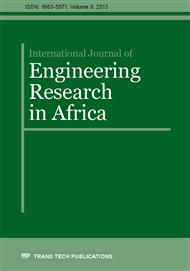[1]
R. Hermann, Geometry, Physics and Systems, Dekker, New York, 1973.
Google Scholar
[2]
P. Salamon, B. Andresen, R.S. Berry, Thermodynamics in finite time. II. Potentials for finite-time processes, Phys. Rev. A. 14 (1977) 2094-2102.
DOI: 10.1103/physreva.15.2094
Google Scholar
[3]
M. Mozurkewich, R.S. Berry, Finite-time thermodynamics: Engine performance improved by optimized piston motion, J. Appl. Phys. 78 (1981) 1986–1988.
DOI: 10.1073/pnas.78.4.1986
Google Scholar
[4]
L. Chen, C. Wu, F. Sun, Finite-time thermodynamic optimization or entropy-generation minimization of energy systems, J. Non-Equil. Thermody. 24 (1999) 327–359.
DOI: 10.1515/jnetdy.1999.020
Google Scholar
[5]
A. Bejan, Entropy-generation minimization: the new thermodynamics of finite-size devices and finite time processes, J. Appl. Phys. 79 (1996) 1191–1218.
DOI: 10.1063/1.362674
Google Scholar
[6]
L. Chen, F. Sun, Advances in finite-time thermodynamics: analysis and optimization. NewYork: Nova Science Publishers, 2004.
Google Scholar
[7]
K.H. Hoffman, S.J. Watowich, R.S. Berry, Optimal paths for thermodynamic systems: the ideal Diesel cycle, J. Appl. Phys. 58 (1985) 2125–2134.
DOI: 10.1063/1.335977
Google Scholar
[8]
M. Mozurkewich, R.S. Berry, Optimal paths for thermodynamic systems: the ideal Otto-cycle, J. Appl. Phys. 53 (1982) 34–42.
DOI: 10.1063/1.329894
Google Scholar
[9]
B.M. Aizenbud, Y.B. Band, O. Kafri, Optimization of a model internal-combustion engine, J. Appl. Phys. 53 (1982) 1277–1282.
DOI: 10.1063/1.330633
Google Scholar
[10]
L. Chen, F. Sun, C. Wu, Optimal expansion of a heated working-fluid with linear phenomenological heat-transfer, Energy Conversion and Management 39 (1998) 149–156.
DOI: 10.1016/s0196-8904(96)00231-2
Google Scholar
[11]
F.L. Curzon, B. Ahlborn, Efficiency of a Carnot engine at maximum power-output, Am. J. Phys. 43 (1975) 22–24.
DOI: 10.1119/1.10023
Google Scholar
[12]
L. Chen, J. Lin, F. Sun, C. Wu, Efficiency of an Atkinson engine at maximum power-density, Energy Conversion and Management 39 (1998) 337–341.
DOI: 10.1016/s0196-8904(96)00195-1
Google Scholar
[13]
A. Al-Sarkhi, B.A. Akash, J.O. Jaber, M.S. Mohsen, E. Abu-Nada, Efficiency of a Miller engine at maximum power-density, Int. Commun. Heat. Mass. Tran. 29 (2002) 1157–1159.
DOI: 10.1016/s0735-1933(02)00444-x
Google Scholar
[14]
B. Sahin, U. Kesgin, A. Kodal, N. Vardar, Performance optimization of a new combined power-cycle based on a power-density analysis of the Dual cycle, Energy Conversion and Management 43 (2002) 2019–2031.
DOI: 10.1016/s0196-8904(01)00149-2
Google Scholar
[15]
X. Qin, L. Chen, F. Sun, The universal power and efficiency characteristics for irreversible reciprocating heat engine cycles, Eur. J. Phys. 24 (2003) 359–366.
DOI: 10.1088/0143-0807/24/4/354
Google Scholar
[16]
Y. Ge, L. Chen, F. Sun, C. Wu, Reciprocating heat-engine cycles, Applied Energy 81 (2005) 397–408.
DOI: 10.1016/j.apenergy.2004.09.007
Google Scholar
[17]
Y. Ge, L. Chen, F. Sun, C. Wu, Performance of an Atkinson cycle with heat transfer, friction and variable specific-heats of the working fluid, Applied Energy 83 (2006) 1210–1221.
DOI: 10.1016/j.apenergy.2005.12.003
Google Scholar
[18]
Y. Zhao, J. Chen, Performance analysis and parametric optimum criteria of an irreversible Atkinson heat-engine, Applied Energy 83 (2006) 789–800.
DOI: 10.1016/j.apenergy.2005.09.007
Google Scholar
[19]
P. Wang, S.S. Hou. Performance analysis and comparison of an Atkinson cycle coupled to variable temperature heat reservoirs under maximum power and maximum power density conditions, Energy Conversion and. Management 46 (2005) 2637–2655.
DOI: 10.1016/j.enconman.2004.11.005
Google Scholar
[20]
A. Al-Sarkhi, B.A. Akash, E. Abu-Nada, I. Al-Hinti, Efficiency of Atkinson Engine at Maximum Power Density using Temperature Dependent Specific Heats, Jordan J. Mech. and Indust. Eng. 2 (2008) 71-75.
DOI: 10.1016/j.icheatmasstransfer.2006.06.014
Google Scholar
[21]
J.C. Lin, S.S. Hou, Influence of heat loss on the performance of an air-standard Atkinson cycle, Applied Energy 84 (2007) 904–920.
DOI: 10.1016/j.apenergy.2007.02.010
Google Scholar
[22]
S.S. Hou, Comparison of performances of air standard Atkinson and Otto cycles with heat transfer considerations, Energy Conversion and. Management 48 (2007) 1683–1690.
DOI: 10.1016/j.enconman.2006.11.001
Google Scholar
[23]
V. Ganesan, Internal Combustion Engines, New Delhi, Tata McGraw-Hill, 1993.
Google Scholar
[24]
L. Chen, T. Zheng, F. Sun, C. Wu, The power and efficiency characteristics for an irreversible Otto cycle, Int. J. Ambient. Energy 24 (2003) 195–200.
DOI: 10.1080/01430750.2003.9674923
Google Scholar
[25]
J. Lin, L. Chen, C. Wu, F. Sun, Finite-time thermodynamic performance of a Dual cycle, Int. J. Energy Res. 23 (1999) 765–772.
DOI: 10.1002/(sici)1099-114x(199907)23:9<765::aid-er513>3.0.co;2-z
Google Scholar
[26]
L. Chen, T. Zheng, F. Sun, C. Wu, The power and efficiency characteristics for an irreversible Otto cycle, Int. J. Ambient. Energy. 24 (2003) 195–200.
DOI: 10.1080/01430750.2003.9674923
Google Scholar
[27]
L. Chen, F. Sun, C. Wu, The optimal performance of an irreversible Dual-cycle, Applied Energy 79 (2004) 3–14.
DOI: 10.1016/j.apenergy.2003.12.005
Google Scholar
[28]
A. Al-Sarkhi, B.A. Akash, J.O. Jaber, M.S. Mohsen, E. Abu-Nada, Efficiency of a Miller engine at maximum power-density, Int. Commun. Heat Mass Tran. 29 (2002) 1157–1159.
DOI: 10.1016/s0735-1933(02)00444-x
Google Scholar
[29]
M.B. Abbassi, M.H. Gahruei, S. Vahidi, Comparison of the Performances of Biodiesel, Diesel, and Their Compound in Air Standard Diesel-Atkinson Cycle, J. American Scien. 8(1) (2012) 223-229.
DOI: 10.4028/www.scientific.net/jera.9.57
Google Scholar
[30]
C. Cheung, S. Lei, Z. Huang. Regulated and unregulated emissions from a diesel engine fueled with biodiesel and biodiesel blended with methanol, Atmospheric Environment. 43 (2009) 4865-4872.
DOI: 10.1016/j.atmosenv.2009.07.021
Google Scholar


